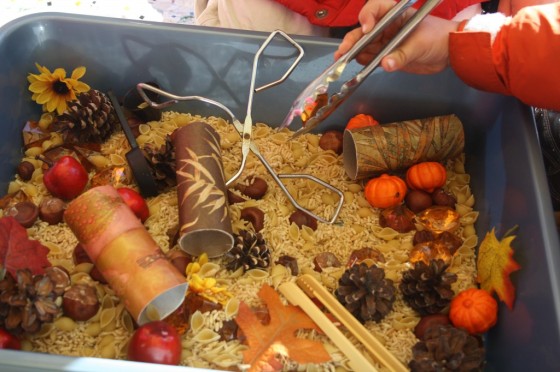Yesterday was a busy apple cooking day, and I made this apple tart for dessert. It was moderately easy and quite good! I used the directions linked to Pioneer Woman Cooks (she's awesome!) because she has lots of pictures of the steps. I tend to only skim directions, which can be a bad thing sometimes. I missed the part about the brown sugar/lemon mixture running a little, so my house smelled like burnt sugar for awhile! Oops! Definitely use a baking sheet with a lip :).
If you're not into cooking from scratch, a really easy version of this would be to mix in some cut up apples, applesauce, brown sugar, and cinnamon into pancake mix. Or maybe just pick a couple of those if you're short on ingredients.
These recipes I'll be trying later this week:
The apple cider in the crock put is supposed to make the house smell AMAZING!
Of course, it doesn't have to be complicated. Here is an apple snack Grace saw in a book and was begging me to make. How could I say no? It was super easy.
If even that is too much for you, just eat your apples with some peanut butter! The kids will appreciate even the simplest apple snack.
A study of apples wouldn't be complete without picking apples. I took my three little friends to Baugher's Orchard in Westminster, Maryland for a little apple picking adventure.
Introduce apple picking with a picture interpretation.
I chose not to tell Grace in advance that we were going apple picking. (I didn't tell Ada or Lucas either, but they have no idea what that means ;). Instead, we did a picture interpretation to get her thinking about the experience. Like a guess box, a picture interpretation is a teaching strategy that promotes critical thinking and analytic skills.
(The following picture interpretation is paraphrased from MCPS PADI - Ricci 2007, 2010 resources.)
1. Choose a picture that links to the topic.
Here are a couple of paintings I found that have to do with apple picking:
You could either print out the picture or just show it on the screen. I will use the first picture, "Apple Picking" by Stina Sunnesson to give examples of what questions to ask.
2. Discuss the painting with your child.
To incorporate the critical thinking skills, you want to ask varying levels of questions, starting from basic and increasing to abstract.
Start by asking your child to identify what is in the picture with questions, like "what do you see?"
Next, move to describing the things that are in the picture. For example, "tell me about the tree" or "what do you notice about the leaves?"
After that, ask your child to interpret the painting. This stage leads to higher-level thinking and inferencing. Ask questions, like "Where does this take place?" What do you think the people are doing?" "What season is it?" "What might the people be saying to each other?"
Finally, extrapolate (what does that mean?!) and have your child draw conclusions about what might be. For example, ask "What would it be like if you were in the picture?" "What do you think the people in the picture will do after this?" "What if this picture was in the winter, what would be different?"
Depending on your child's age and stage of development, you may have to alter the questions a little or rely mainly on concrete questions. But the more you do this type of activity with your child, he/she will get better at it.
3. Make a connection between the picture interpretation and the topic.
Explain to your child why the picture is relevant, or say, "can you figure out what we are going to do tomorrow?" This is a good way to get your child relating all that thinking they just did with an upcoming trip to the apple orchard.
I did this picture interpretation with Grace and she actually showed me she knew a lot more about apple picking than I expected. She also enjoyed the challenge of answering my questions.
Go to an apple orchard!
If you can, pick your own apples! The cool thing about doing this, besides spending a day outside in beautiful fall weather, is that it shows REAL apples and REAL apple trees. It also gives kids an idea of how we get our food, and they can add to their understanding of farms! Plus, they get to see some rotting apples on the ground, which can spark a discussion about the life cycle of an apple tree.
We had a GORGEOUS day for our apple picking adventure, and thankfully my hubby, Matt, was able to come along! This is definitely a two-man job for this little gang of 3.
 |
| Ada hoarding the apples |
 |
| Trying to keep Lucas from early tasting |
Baugher's Orchard has a great country store, where you can pick up a tractor ride to the apple fields. They also have a picnicking area and a fun, little playground that the kids LOVED.
We got some apples from the fields and peaches, mums, and a peach pie from the store! I'd say it was a success!


+-+Copy.JPG)






























![[IMG_2039.JPG]](https://blogger.googleusercontent.com/img/b/R29vZ2xl/AVvXsEil4UNMOXzqdIwOauqZaDE4aUuw1BYxcc3oxhjpDHIKRDaoOFcakvGmtshuvQ2NE39UyYsA7590S4_2FHufF48lZsQDyA8ygYHxwr4jcs_39oE36puawurOq2B7J_hkb9IRnFCljljXbPXx/s400/IMG_2039.JPG)





















